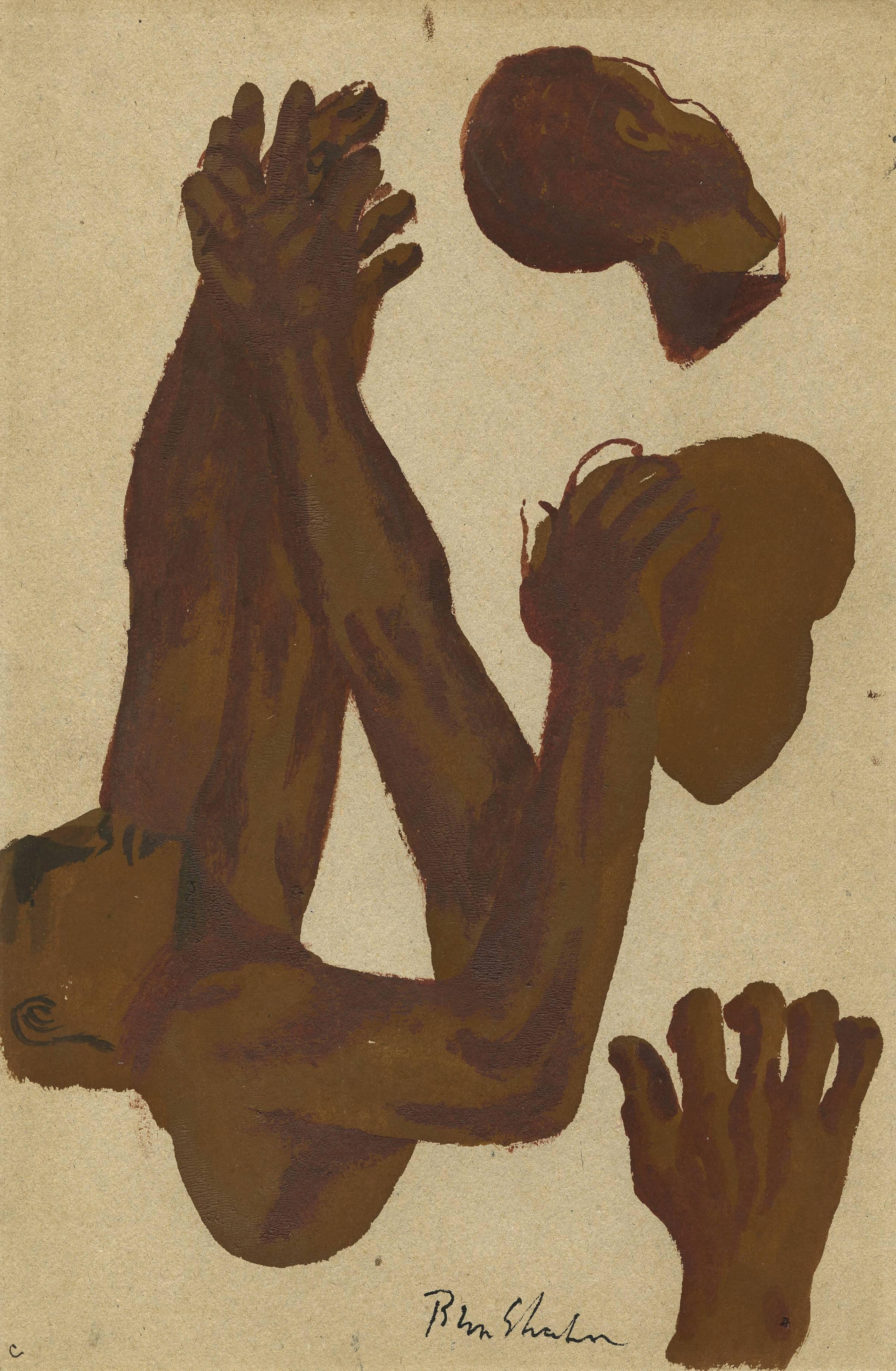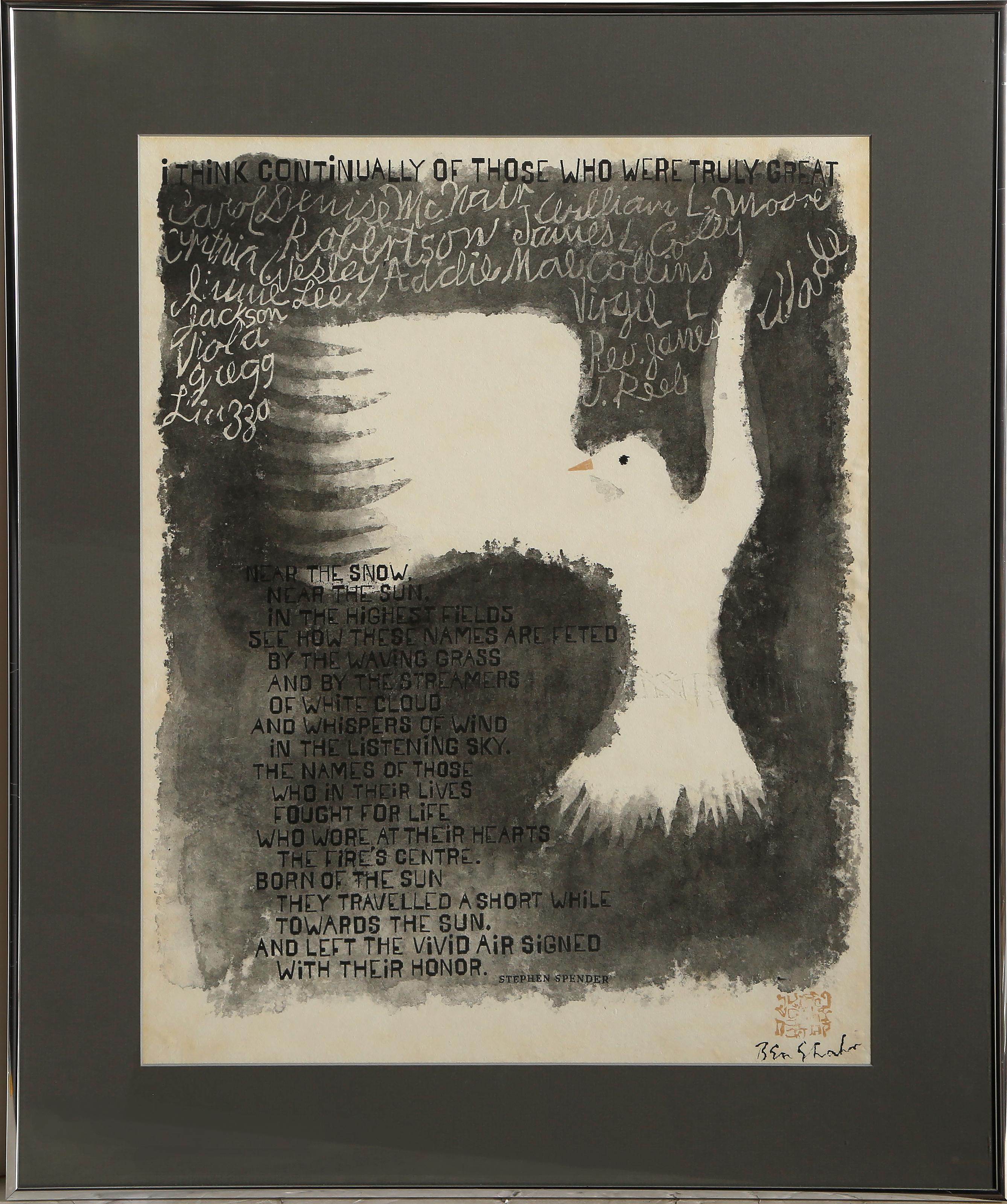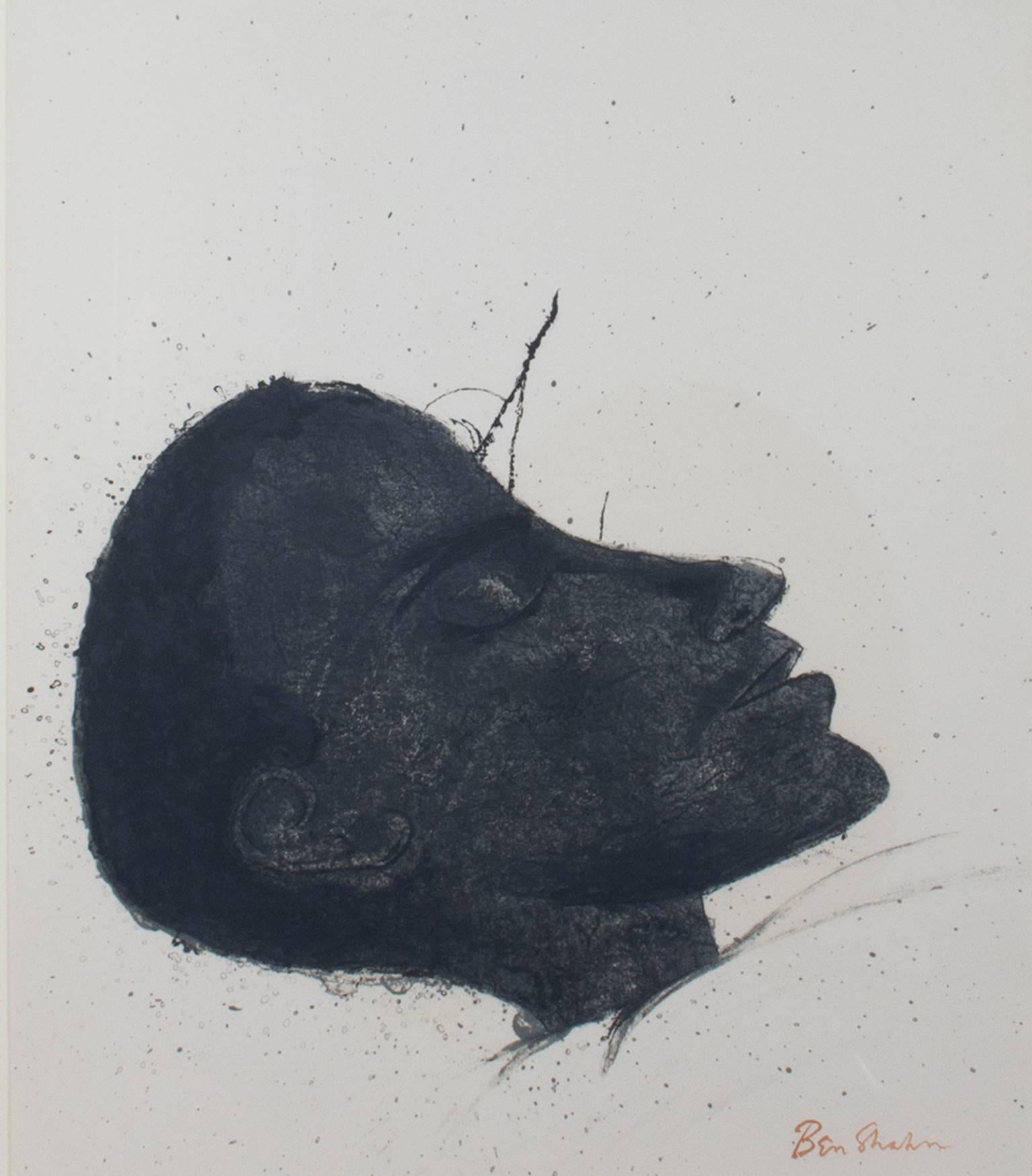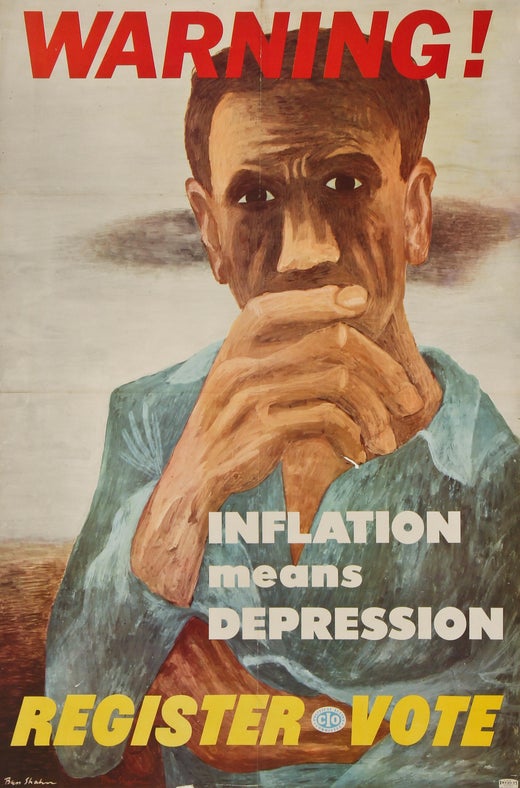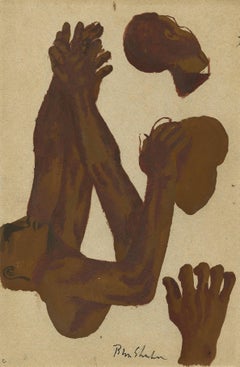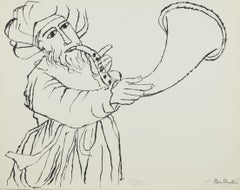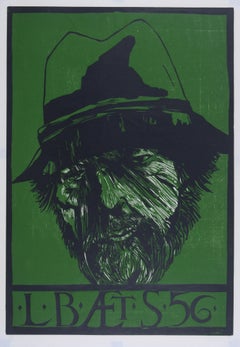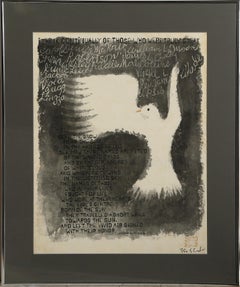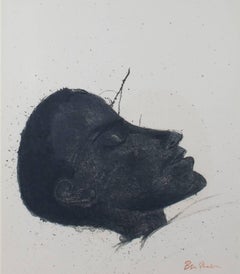Items Similar to WARNING! Register*Vote, INFLATION means DEPRESSION
Want more images or videos?
Request additional images or videos from the seller
1 of 12
Ben ShahnWARNING! Register*Vote, INFLATION means DEPRESSION1946
1946
$3,250
£2,479.67
€2,822.91
CA$4,567.91
A$5,021.25
CHF 2,636.13
MX$59,706.24
NOK 33,853.91
SEK 30,837.25
DKK 21,091.65
About the Item
WARNING! Register*Vote, INFLATION means DEPRESSION
Photo lithograph, 1946
Signed in the image lower left
Published by CIO (Congress of Industrial Organizations) before their merger with the AFL (American Federation of Labor) see photo
Edition: unknown
This is a poster that was in high usage throughout the country. Very few have survived.
Condition: Issues as with a used poster (folds and small voids)
Framed with glass
Frame size: 45 1/4 x 31 1/2" , see photo
A copy of this important American union organizing poster is in the collection of MOMA, NYC
Provenance: Brand Werthan Collection
Ben Shahn was a very early Progressive active in the art and politcal communities. His works are in most major museums. His cultural impact cannot be overstated.
- Creator:Ben Shahn (1898-1969, American)
- Creation Year:1946
- Dimensions:Height: 41 in (104.14 cm)Width: 27 in (68.58 cm)
- Medium:
- Movement & Style:
- Period:
- Condition:
- Gallery Location:Fairlawn, OH
- Reference Number:Seller: FA99001stDibs: LU14013526072
Ben Shahn
Ben Shahn (1898 – 1969) was a Lithuanian-born American artist. He is best known for his works of social realism, his left-wing political views, and his series of lectures published as The Shape of Content. Shahn began his path to becoming an artist in New York, where he was first trained as a lithographer. Shahn's early experiences with lithography and graphic design is apparent in his later prints and paintings which often include the combination of text and image. Shahn's primary medium was egg tempera, popular among social realists. Shahn mixed different genres of art. His body of art is distinctive for its lack of traditional landscapes, still lifes, and portraits. Shahn used both expressive and precise visual languages, which he coalesced through the consistency of his authoritative line. Shahn is also noted for his use of unique symbolism, which is often compared to the imagery in Paul Klee's drawings. His art is striking but also introspective. He often captured figures engrossed in their own worlds. Although he used many mediums, his pieces are consistently thoughtful and playful.
About the Seller
5.0
Recognized Seller
These prestigious sellers are industry leaders and represent the highest echelon for item quality and design.
Gold Seller
Premium sellers maintaining a 4.3+ rating and 24-hour response times
Established in 1978
1stDibs seller since 2013
835 sales on 1stDibs
Typical response time: <1 hour
Associations
International Fine Print Dealers Association
- ShippingRetrieving quote...Shipping from: Fairlawn, OH
- Return Policy
More From This Seller
View AllBasketball Player
By Ben Shahn
Located in Fairlawn, OH
Basketball Player
Gouache on card stock, c. 1940
Signed by the artist in ink lower center
A study for the fresco mural in the Social Security Buildin...
Category
1940s American Modern Figurative Paintings
Materials
Gouache
Man Sounding Horn (Psalm 150)
By Ben Shahn
Located in Fairlawn, OH
Man Sounding Horn (Psalm 150)
Lithograph, 1969-1970
Estate signed: "Ben Shahn/by B.B. Shahn" in pencil lower center
Stamped signature lower right (see photo)
Signed by Mourlot Lith. in pencil lower right (see photo)
Edition: 125 (67/125) see photo
Psalm 150, "A Hallelujah Chorus"
Published by Kennedy Graphics, Ltd., New York, NY
Printed by Mourlot Graphics, Ltd., New York, NY
Reference: Prescott 255
Kennedy Galleries, The Kennedy Graphics, 380, reproduced
Condition: Very good
Image/sheet size: 20 1/8 x 25 3/8 inches
A posthumous print
"This was the final project completed by Ben Shahn (1898-1969), leading American realist painter and muralist widely recognized for his socially conscious works. Born in Lithuania to Jewish parents, Shahn emigrated to the United States in 1906 and became a popular and versatile artist who worked in a variety of media and on a range of projects. His credits are as varied as assistant to muralist Diego Rivera, photographer for the Resettlement Administration (alongside the likes of Dorothea Lange and his friend, Walker Evans), maker of posters for the Office of War Information during WWII, and commercial artist for CBS. He is best known, however, for artwork depicting left-leaning political ideals and highlighting social concerns, such as his series of gouache paintings known as "The Passion of Sacco and Vanzetti...
Category
1960s American Modern Figurative Prints
Materials
Lithograph
Untitled (Double sided watercolor) Recto: Figures seated at a table
By Ben Shahn
Located in Fairlawn, OH
Watercolor on paper
Most probably related to the artist's creation of images surrounding Haggadah (Passover) which he started in 1930 and finished with the publication of his book in...
Category
1960s American Modern Figurative Drawings and Watercolors
Materials
Watercolor
Self Portrait-L.B. AET 56
By Leonard Baskin
Located in Fairlawn, OH
Self Portrait-L.B. AET 56
Color woodcut printed in black and green, 1978
Signed in pencil lower right (see photo)
Edition: 150 (97/150)
Condition: Excellent
Image: 32 x 22”
Sheet: 35...
Category
1970s American Modern Figurative Prints
Materials
Woodcut
Self Portrait (With Model)
By Raphael Soyer
Located in Fairlawn, OH
Self Portrait (With Model)
Lithograph, 1959-1960
Signed and numbered in pencil (see photos)
Edition: 50 (30/50)
Commissioned by ACA Gallery, NYC
Depicts the artist in his studio at S...
Category
1950s American Modern Portrait Prints
Materials
Lithograph
Die Bettler (The Beggars)
By Max Beckmann
Located in Fairlawn, OH
Die Bettler (The Beggars)
Lithograph, 1922
Signed in pencil lower right (see photo)
From: Berliner Reise Series, Plate 7
Printed on wove paper
Edition: 100...
Category
1920s Expressionist Figurative Prints
Materials
Lithograph
You May Also Like
Partings Long Seen Coming from the Rilke Portfolio
By Ben Shahn
Located in Long Island City, NY
Artist: Ben Shahn, American (1898 - 1969)
Title: Partings Long Seen Coming from the Rilke Portfolio
Year: 1968
Medium: Lithograph on Richard de Bas, si...
Category
1960s American Realist Figurative Prints
Materials
Lithograph
I Think Continually Of Those... from 9 Drawings, Modern Lithograph by Ben Shahn
By Ben Shahn
Located in Long Island City, NY
The Nine Drawings Portfolio is a strong example of Shahn’s commitment to the struggle for social justice and racial equity. It was “published and distributed as part of a fund-raisin...
Category
1960s Modern Figurative Prints
Materials
Lithograph
"Beside the Dying, " an Original Lithograph signed by Ben Shahn
By Ben Shahn
Located in Milwaukee, WI
"Beside the Dying" is an original signed lithograph by Ben Shahn. This print is from the series "For the Sake of a Single Verse" and depicts the head of a man in dark gray seemingly asleep or dead on a white background. It is signed lower right and is edition 27/200.
22" x 17" art
32 3/8" x 27 3/8" frame
Ben Shahn (American, September 12, 1898 - March 14, 1969) was a painter, lithographer, and photographer best known for his left-wing political leanings, works of social realism, and The Shape of Content, a publication of his lectures. Shahn was born in Kovno, Lithuania, when the country was still occupied by the Russian Empire. In 1902, Shahn's father, Joshua Hessel, was exiled to Siberia. Shahn then moved to Vilkomir, Lithuania, with his mother, Gittel, and his two siblings. Their family moved to the United States in 1906 to join their father who had fled from exile. After settling in Brooklyn, NY, Shahn began to train in lithography and graphic design, and his favorite medium was egg tempera. In 1919, Shahn enrolled in New York University to study Biology before entering the City College in 1921 to study Art. He also studied Art at the National Academy of Design. In the 1920s, Shahn and his wife traveled around Africa and Europe to study the works of renowned artists such as Pablo Picasso (Spanish, 1881- 1973) and Raoul Dufy (French, 1877-1953).
In 1933, Shahn worked as an assistant of Diego Rivera (Mexican, 1886 - 1957); at this time, Rivera was working on the mural at the Rockefeller Center in New York. Two years later, Shahn was recommended by Walker Evans (American, 1903 - 1975) to join the Farm Security Administration photographic group. One of the artist’s most famous works is the fresco mural he did for the Jersey Homesteads' community center. Shahn also worked on murals for the state on the Federal Security Building and the Bronx Central Annex Post Office.
During the Second World War, Shahn made a series of paintings laced...
Category
1960s Portrait Prints
Materials
Lithograph
Beside the Dying from the Rilke Portfolio, Ben Shahn
By Ben Shahn
Located in Long Island City, NY
Artist: Ben Shahn, American (1898 - 1969)
Title: Beside the Dying from the Rilke Portfolio
Year: 1968
Medium: Lithograph, signed in the plate
Edition: 750
Size: 22.5 x 17.75 in. (57...
Category
1960s Modern Figurative Prints
Materials
Lithograph
We Shall Overcome, Portrait, MLK Lithograph by Ben Shahn
By Ben Shahn
Located in Long Island City, NY
The Nine Drawings Portfolio is a strong example of Shahn’s commitment to the struggle for social justice and racial equity. It was “published and distributed as part of a fund-raisin...
Category
1960s Modern Figurative Prints
Materials
Lithograph
Untitled - Mixed Media by Ben Shahn - 1950s
By Ben Shahn
Located in Roma, IT
Untitled is an drawing realized by Ben Shahn (Kovno 1898-New York 1969)
Pen drawing on paper applied on canvas.
Hand-signed lower right: Ben Shahn.
Some light folds and discoloring...
Category
1950s Contemporary Figurative Drawings and Watercolors
Materials
Canvas, Mixed Media, Paper
More Ways To Browse
Keith Haring Signed Poster
Keith Haring South Africa
Le Cocu Magnifique
Leroy Neiman Golf
Leroy Neiman Originals
Les Caprices De Goya
Marc Chagall Green
Marc Chagall Rooster
Marc Chagall Unsigned Lithographs
Maria Rivans
Marker Keith Haring
Mermaid Poster
Moulin Rouge Cheret Original Poster
Ogata Gekko
Orchestra Poster
Pablo Picasso Signature
Peter Max Angel With Heart
Peter Max Composition Red And Green
